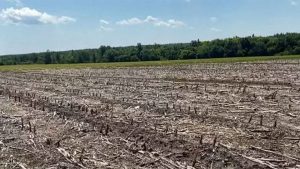
Munther Zeid has noticed his customers getting less bang for their buck at his Foodfare grocery stores in Winnipeg over the past few weeks.
Prices for everything from beef to bread have slowly risen, while products that haven’t gotten more expensive — like ice cream, juice and Cheez Whiz — have gotten smaller, Zeid said.
Those are just a few examples of how the challenges producers are facing at the top end of the food supply chain, along with changes such as increased shipping costs brought on during the pandemic, have trickled down to affect consumers, he said.
Last month, Canada’s inflation rate climbed to 3.7 per cent, its highest point in a decade.
While overall food prices only increased by 1.7 per cent, specific items in that category saw higher jumps: meat prices climbed by 3.1 per cent, while dairy rose by 3.5.
And this summer’s extreme weather — including a months-long drought that hit Manitoba farmers hard, followed by a recent deluge of rain that for many producers came too late — has also affected producers on a much smaller scale.
But the executive director of Direct Farm Manitoba, a co-operative of producers that sell directly to customers, said it’s still too early to tell whether that will lead to a price hike for things like honey and strawberries at the farmers’ market.
“We really have to wait until the next season to see how those impacts play out,” said Kristie Beynon.
Zeid said he doesn’t think the costs of food at his five stores have risen enough to catch most people’s attention just yet.
“When you’re [used to] spending, say, 100 bucks and it’s [now] 102, 103, most people won’t notice that,” he said.

But for some, those few dollars are the difference between buying what they need and making do with what they can afford, said Megan Erbus, advocacy and impact manager for the food bank network Harvest Manitoba.
“When folks have a really restricted income, which is generally what happens for folks that have to access our services, it does make a big difference,” she said.
Unhealthy compromises
Erbus said her non-profit conducted a survey among its food bank clients in October that turned up that exact conclusion.
Almost all of Harvest Manitoba’s clients — 90 per cent of those surveyed — said they’ve had to make compromises when grocery shopping because of rising food prices.
“Around some of the items that tend to be more costly, like meat or dairy products, they would often not purchase those items — or purchase items that would be less healthy, rather — to be able to sort of supplement those costs,” Erbus said.
The organization has seen an uptick in demand too, with about 250 new clients using its food bank services every month, she said.
For many people in the province, their ability to access and afford enough food has been an issue for years, said Rob Moquin, executive director of Food Matters Manitoba, a non-profit that works to improve what’s known as food security.
Before the pandemic, about one in seven Manitoba families was food insecure, while one in five children lived in a household without enough food — something only exacerbated by a hike in prices at the grocery store, Moquin said.

“More people, I think, are feeling the pinch. More people have felt food insecurity for the first time, perhaps,” he said.
But food banks making sure people have enough to eat only solves part of the problem, he said.
What’s needed next, Moquin said, is a critical look at how to eliminate the gaps in food security by making sure people have things like adequate income, housing and child care — “the essentials of life.”
“What kind of institutional system of change do we need to sort of eliminate that need in the first place?” he said.
“These are big questions that need to be dealt with.”

























